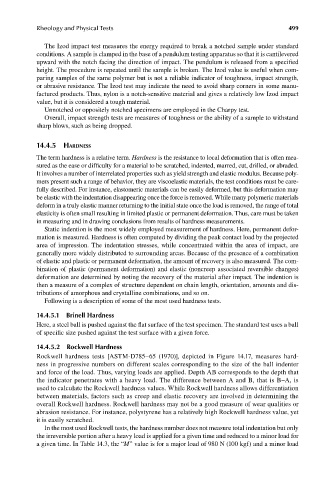Page 536 - Carrahers_Polymer_Chemistry,_Eighth_Edition
P. 536
Rheology and Physical Tests 499
The Izod impact test measures the energy required to break a notched sample under standard
conditions. A sample is clamped in the base of a pendulum testing apparatus so that it is cantilevered
upward with the notch facing the direction of impact. The pendulum is released from a specifi ed
height. The procedure is repeated until the sample is broken. The Izod value is useful when com-
paring samples of the same polymer but is not a reliable indicator of toughness, impact strength,
or abrasive resistance. The Izod test may indicate the need to avoid sharp corners in some manu-
factured products. Thus, nylon is a notch-sensitive material and gives a relatively low Izod impact
value, but it is considered a tough material.
Unnotched or oppositely notched specimens are employed in the Charpy test.
Overall, impact strength tests are measures of toughness or the ability of a sample to withstand
sharp blows, such as being dropped.
14.4.5 HARDNESS
The term hardness is a relative term. Hardness is the resistance to local deformation that is often mea-
sured as the ease or difficulty for a material to be scratched, indented, marred, cut, drilled, or abraded.
It involves a number of interrelated properties such as yield strength and elastic modulus. Because poly-
mers present such a range of behavior, they are viscoelastic materials, the test conditions must be care-
fully described. For instance, elastomeric materials can be easily deformed, but this deformation may
be elastic with the indentation disappearing once the force is removed. While many polymeric materials
deform in a truly elastic manner returning to the initial state once the load is removed, the range of total
elasticity is often small resulting in limited plastic or permanent deformation. Thus, care must be taken
in measuring and in drawing conclusions from results of hardness measurements.
Static indention is the most widely employed measurement of hardness. Here, permanent defor-
mation is measured. Hardness is often computed by dividing the peak contact load by the projected
area of impression. The indentation stresses, while concentrated within the area of impact, are
generally more widely distributed to surrounding areas. Because of the presence of a combination
of elastic and plastic or permanent deformation, the amount of recovery is also measured. The com-
bination of plastic (permanent deformation) and elastic (noncreep associated reversible changes)
deformation are determined by noting the recovery of the material after impact. The indention is
then a measure of a complex of structure dependent on chain length, orientation, amounts and dis-
tributions of amorphous and crystalline combinations, and so on.
Following is a description of some of the most used hardness tests.
14.4.5.1 Brinell Hardness
Here, a steel ball is pushed against the flat surface of the test specimen. The standard test uses a ball
of specific size pushed against the test surface with a given force.
14.4.5.2 Rockwell Hardness
Rockwell hardness tests [ASTM-D785–65 (1970)], depicted in Figure 14.17, measures hard-
ness in progressive numbers on different scales corresponding to the size of the ball indenter
and force of the load. Thus, varying loads are applied. Depth AB corresponds to the depth that
the indicator penetrates with a heavy load. The difference between A and B, that is B–A, is
used to calculate the Rockwell hardness values. While Rockwell hardness allows differentiation
between materials, factors such as creep and elastic recovery are involved in determining the
overall Rockwell hardness. Rockwell hardness may not be a good measure of wear qualities or
abrasion resistance. For instance, polystyrene has a relatively high Rockwell hardness value, yet
it is easily scratched.
In the most used Rockwell tests, the hardness number does not measure total indentation but only
the irreversible portion after a heavy load is applied for a given time and reduced to a minor load for
a given time. In Table 14.3, the “M” value is for a major load of 980 N (100 kgf) and a minor load
9/14/2010 3:42:42 PM
K10478.indb 499
K10478.indb 499 9/14/2010 3:42:42 PM

